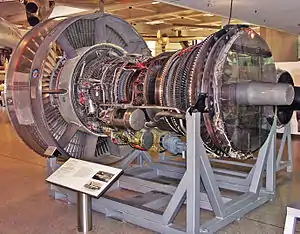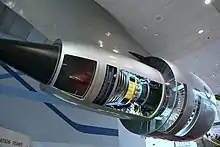Pratt & Whitney JT9D
The Pratt & Whitney JT9D engine was the first high bypass ratio jet engine to power a wide-body airliner. Its initial application was the Boeing 747-100, the original "Jumbo Jet". It was Pratt & Whitney's first high-bypass-ratio turbofan.[2]
| JT9D | |
|---|---|
 | |
| The internal structure of the JT9D | |
| Type | Turbofan |
| National origin | United States |
| Manufacturer | Pratt & Whitney |
| First run | December 1966 |
| Major applications | Airbus A300/A310 Boeing 747 Boeing 767 McDonnell Douglas DC-10 |
| Number built | more than 3,200[1] |
| Developed into | Pratt & Whitney PW4000 |
Development

The JT9D program was launched in September 1965 and the first engine was tested in December 1966. It received its FAA certification in May 1969 and entered service in January 1970 on the Boeing 747. It subsequently powered the Boeing 767, Airbus A300 and Airbus A310, and McDonnell Douglas DC-10. The enhanced JT9D-7R4 was introduced in September 1982 and was approved for 180-minute ETOPS for twinjets in June 1985. By 2020, the JT9D had flown more than 169 million hours. Production ceased in 1990,[3] to be replaced by the new PW4000.
The JT9D was developed from the STF200/JTF14 demonstrator engines.[4] The JTF14 engine had been proposed for the C-5 Galaxy program but the production contract was awarded to the General Electric TF39. The engine's first test run took place in a test rig at East Hartford, Connecticut, with the engine's first flight in June 1968 mounted on a Boeing B-52E which served as a JT9D flying testbed.[5] In 1968, its unit cost was $800,000,[6] $6.7 million today.
Design
The JT9D introduced advanced technologies in structures, aerodynamics, and materials, which included titanium alloys and nickel alloys, to improve fuel efficiency and reliability compared to the Pratt & Whitney JT3D earlier turbofan.[3] The engine featured a single-stage fan, a three-stage low-pressure compressor, and an eleven-stage high-pressure compressor coupled to a two-stage high-pressure turbine and four-stage low-pressure turbine. The JT9D-3, the earliest certified version of the engine, weighed 8,470 lb (3,840 kg) and produced 43,500 lbf (193 kN) thrust.[7]
Pratt & Whitney faced difficulties with the JT9D design during the Boeing 747 test program. Engine failures during the flight test program resulted in thirty aircraft being parked outside the factory with concrete blocks hanging from the pylons, awaiting redesigned engines. Boeing and Pratt & Whitney worked together in 1969 to solve the problem. The trouble was traced to ovalization, in which stresses during takeoff caused the engine casing to deform into an oval shape resulting in rubbing of high-pressure turbine blade tips. This was solved by strengthening the engine casing and adding yoke-shaped thrust links.[8]
JT9D engines powering USAF Boeing E-4A airborne command posts were designated F105.
Variants
All variants have the same number of compressor and turbine stages.[9][10]
| Comp. | Model | Certification | Takeoff, dry | Length | Width | Weight | LP rpm | HP rpm | T/W | Fan[lower-alpha 1] | Application |
|---|---|---|---|---|---|---|---|---|---|---|---|
| 15-stage[9] | JT9D-3A | Jan 9, 1970 | 43,500 lbf (193 kN) | 154.89 in 3.934 m |
95.60 in 2.428 m |
8,713 lb (3.952 t) | 3650 | 7850 | 4.99 | 92.3 in 2.34 m |
Boeing 747[11] |
| JT9D-7 | Jun 14, 1971 | 45,500 lbf (202 kN) | 8,880 lb (4.03 t) | 3750 | 8000 | 5.12 | |||||
| JT9D-7A | Sep 22, 1972 | 46,150 lbf (205.3 kN) | 5.2 | ||||||||
| JT9D-20 | Oct 16, 1972 | 44,500 lbf (198 kN) | 8,470 lb (3.84 t) | 3650 | 5.25 | McDonnell Douglas DC-10[12] | |||||
| JT9D-7H | Jun 19, 1974 | 45,500 lbf (202 kN) | 8,880 lb (4.03 t) | 5.12 | Boeing 747[11] | ||||||
| JT9D-7AH | 46,150 lbf (205.3 kN) | 5.2 | |||||||||
| JT9D-7F | Sep 30, 1974 | 46,750 lbf (208.0 kN) | 3750 | 5.26 | |||||||
| JT9D-7J | Aug 31, 1976 | 48,650 lbf (216.4 kN) | 5.48 | ||||||||
| JT9D-20J | Dec 29, 1986 | 48,050 lbf (213.7 kN) | 8,580 lb (3.89 t) | 5.6 | McDonnell Douglas DC-10[12] | ||||||
| 16-stage[10] | JT9D-59A | Dec 12, 1974 | 51,720 lbf (230.1 kN) | 154.256 in 3.9181 m |
97.03 in 2.465 m |
9,140 lb (4.15 t) | 3780 | 8011 | 5.66 | 93.6 in 2.38 m |
McDonnell Douglas DC-10[12] Airbus A300[13] |
| JT9D-70A | 51,140 lbf (227.5 kN) | 9,155 lb (4.153 t) | 5.59 | Boeing 747[11] | |||||||
| JT9D-7Q | Oct 31, 1978 | 51,900 lbf (231 kN) | 9,295 lb (4.216 t) | 3888 | 8000 | 5.58 | |||||
| JT9D-7Q3 | Oct 22, 1979 | 3960 | 5.58 | ||||||||
| JT9D-7R4D | Nov 25, 1980 | 48,000 lbf (210 kN) | 96.00 in 2.438 m |
8,935 lb (4.053 t) | 3770 | 5.37 | 93.4 in 2.37 m |
Boeing 767[14] | |||
| JT9D-7R4D1 | Apr 1, 1981 | 8,915 lb (4.044 t) | 3810 | 5.38 | Airbus A310[13] | ||||||
| JT9D-7R4E | 50,000 lbf (220 kN) | 3770 | 5.61 | Boeing 767[14] | |||||||
| JT9D-7R4E1 | 154.295 in 3.9191 m |
8,935 lb (4.053 t) | 3810 | 5.6 | Airbus A310[13] | ||||||
| JT9D-7R4G2 | Jul 23, 1982 | 54,750 lbf (243.5 kN) | 9,170 lb (4.16 t) | 3825 | 8080 | 5.97 | Boeing 747[11] | ||||
| JT9D-7R4H1 | 56,000 lbf (250 kN) | 8,915 lb (4.044 t) | 3810 | 6.28 | Airbus A300-600[13] | ||||||
| JT9D-7R4E4 | Mar 29, 1985 | 50,000 lbf (220 kN) | 8,935 lb (4.053 t) | 5.6 | Boeing 767[14] |
Applications
- Airbus A300
- Airbus A310
- Boeing 747-100/200/300/SP
- Boeing 767 (early models)
- Boeing RC-1
- McDonnell Douglas DC-10-40
Specifications (JT9D-7R4)
Data from Pratt & Whitney[3]
General characteristics
- Type: High bypass turbofan
- Length: 132.7 in (3.37 m) (flange to flange)
- Diameter: 93.4 in (2.37 m) (fan tip)
- Dry weight: 8,608 lb (3,905 kg)
Components
- Compressor: 3-stage low pressure 11-stage high pressure axial
- Turbine: 2-stage high pressure 4-stage low pressure
Performance
- Maximum thrust: 48,000–56,000 lbf (214–249 kN) takeoff (flat rated at 86 °F (30 °C)) Note: the thrust range applies to various -7R4 variants for different aircraft.
- Overall pressure ratio: overall 26.7 (fan 1.67:1)
- Bypass ratio: 4.8:1
See also
Related development
Comparable engines
Related lists
References
- "Commercial Engines / JT9D". Pratt & Whitney.
- Gunston, Bill. World Encyclopedia of Aero Engines. Cambridge, England. Patrick Stephens Limited, 1989. ISBN 1-85260-163-9, p.126.
- "JT9D" (PDF). Pratt & Whitney.
- The Engines of Pratt & Whitney: A Technical History, Jack Connors, ISBN 978 1 60086 711 8, p.409
- The Engines of Pratt & Whitney: A Technical History, Jack Connors, ISBN 978 1 60086 711 8, p.412
- Aero Engines 1968 Flight International 4 January 1968
- The Engines of Pratt & Whitney A Technical History, Jack Connors, ISBN 978 1 60086 711 8, Table 3
- Flight International, 13 November 1969, p.749
- "Type Certificate data sheet Number E20EA" (PDF). FAA. February 10, 2000.
- "Type Certificate data sheet Number E3NE" (PDF). FAA. July 25, 2019.
- "Type Certificate Data Sheet NO. A20WE" (PDF). FAA. February 27, 2015.
- "Type Certificate Data Sheet A22WE" (PDF). FAA. April 30, 2018.
- "Type certificate data sheet A.172 for Airbus A300, A310 and A300-600" (PDF). EASA. 11 March 2019. Archived from the original (PDF) on 16 March 2019. Retrieved 26 March 2020.
- "Type Certificate Data Sheet No. A1NM" (PDF). June 20, 2016. Archived from the original (PDF) on September 29, 2018. Retrieved March 26, 2020.